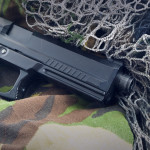This week I realized I’ve seen way too many people training for handgun defenses without any real tactical orientation. Today, I’m writing about the tap and rack process, dubbed Smack & Rack, by the Kravology team.
It’s vitally important to understand two major tactical and safety issues with the Smack & Rack procedure.
First, the procedure can be completed using one of two primary methods. Each method has common elements that are vital to a successful outcome.
- Initially, the orientation of the muzzle in each method must be pointed at the bad guy. Remember, if you have to work on the bad guy, you need both a hot (functioning handgun) and cold (non-operational handgun used as a blunt object) option depending upon the immediate tactical need and the corresponding “condition” of your weapon. So, build these tactics into your defense.
- Secondly, note that only one hand moves during Smack & Rack to better ensure a safe procedure and to keep the movement created by Smack & Rack in a relatively small and manageable space. Notice on the video how one method has the gun hand moving ONLY, while the other procedure has the off-hand moving ONLY.
Check out the video provided and add these tactics to your training. Ensure your tactics after your defense are as solid as the defense itself.
…walk in peace.





Jaime Guzman
My question is on a different scenario. If you were to draw your weapon from your side hip holster, at what point would it be safe to charge your weapon or make it “HOT” and ready to use. I have a Glock 27 and I’m not comfortable at all carrying my gun charged and ready or what you call “one in the chamber” on my hip at all times. What would be the safest procedure on making my gun “HOT” if you would ever have to use it.
CJK
Jaime,
I understand your issue. To go hot, you’ll need space, as space equals time. As a rule, I have my students train to “fight to their weapon.” Fighting to your weapon also implies space and time. If scenarios are presented where space is not an option, you’ll need to train to effectively go hot in very close quarters – advanced training with some necessary and unattractive trade-offs.
Many people, for these reasons, carry hot. The only reliable and effective means of doing so is with a good holster made for your model firearm sitting tightly on your hip (in this case). This provides a replicable and reliable location from which to access and present your firearm. You may also look into various retention holsters if you decide to carry hot. Several holsters provides various retention devices that can offer additional piece of mind.
As for me, I like a good leather or leather/kydex combination. Milt Sparks and Crossbreed holsters come to mind. You might also look into some good handgun retention classes. I’d much rather carry hot and be ready to retain my weapon than carry cold.
It’s up to you. Whatever you decide, get some good training, commit to your decision, and prepare for the specific risks you’re embracing with your style of carry. Finally, situational awareness plays a big role in allowing you access to your handgun; create your own SA process and refine it as you use it.
…walk in peace
Abel Garcia
Chief Kirk, an Instructor and I were discussing this video just this morning. We were considering your comments/recommendation to avoid striking the attacker with the handgun while holding it one hand and your well explained reason for not doing so (bending of the wrist and potential loss of weapon control). However, we were questioning whether there would be the same concern regarding potentially losing control of the weapon if you were to attempt to strike your attacker with the gun in one hand utilizing a hammer fist combative, as if you took the weapon in a gun from the side, behind the arm defense?
CJK
Able,
Don’t get me wrong; you can strike with the handgun in several ways. The issue is, what are the risks (outside the debate as to whether or not re-introducing a handgun back into the reach of the attacker). A hammerfist with the handgun does offer substantial risk – specifically the handgun squirting out the back of the hand upon hard impact. These risks can be amplified based on the size of the weapon and gripping surface.
In the end, you should practice these strikes with hard targets and experience first-hand the potential risks and rewards.
Good luck!